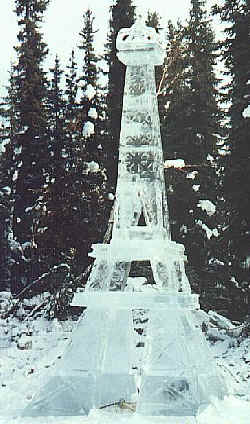The Mysteries of Melting

Most children understand that a snow cone quickly melts, but physicists still do not agree on the details of the process. A thin liquid layer forms on ice, but measurements of its thickness vary widely. A 22 March PRL paper analyzes the effects of impurities on the melting process and offers a theory that explains the variations. It also offers new insights into the nature of melting, a process with many environmental consequences.
The ice cubes in your freezer appear to be strictly solid, but even below the freezing point of water, a thin liquid film exists on the surface of each cube. This liquid layer, or “premelt,” can be up to 100 nm thick, and it is fundamental to the equilibrium of the solid state. The theory of premelting describes how the surface of the solid morphs to create the water film, and how the thickness of the film increases as the temperature is increased from below freezing up to the melting point. Premelting plays a central role in several large-scale effects, such as the slip of glaciers over bedrock, ozone-destroying reactions on atmospheric ice crystals, and even ice skating.
But laboratory measurements of the premelt thickness versus temperature have produced results that differ by about a factor of 100. The reason, claims John Wettlaufer of the University of Washington in Seattle, is the inevitable presence of impurities in the liquid film. “If you include the effect of impurities, what you find is that essentially immeasurable amounts of impurity can give you the sorts of variability that you observe from lab to lab. These amounts are probably impossible to keep out of your experiment.”
Wettlaufer considered the various processes that determine the thickness of a liquid film below the melting point. For a contaminated liquid, there are three competing factors: the energy to convert ice to water; the van der Waals forces between molecules; and, for a contaminant like salt, electric charge interactions between the ions. He found that even tiny amounts of impurity (one molecule of salt for every 100 million molecules of water) significantly affect the film thickness and can account for the wide disparity of the experimental results. Since nearly everything dissolves in water, no experiment can be expected to be pure. “Forget trying to be clean,” says Wettlaufer. “Why not deliberately dope your system? If everyone dopes their system in the same way at least then the impurity effect is unambiguous.”
Larry Wilen of Ohio University in Athens says that Wettlaufer’s work is the first study to model interfacial melting and include all of the interactions which may be present in the system. “Given that impurities in ice typically migrate to, and reside at boundaries, it is crucial to put in the effects of these impurities in models of interfacial melting,” says Wilen. “This is extremely useful for modeling “real world” situations and for making contact with a variety of experimental measurements.”
–David Appell
David Appell is a freelance science writer.


